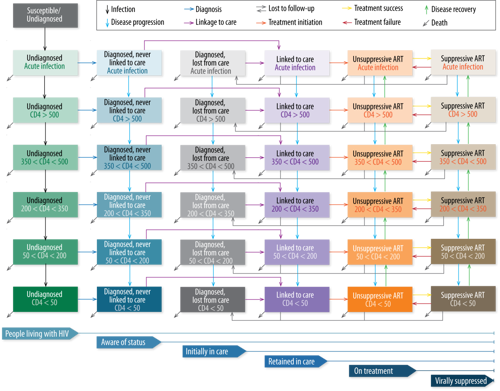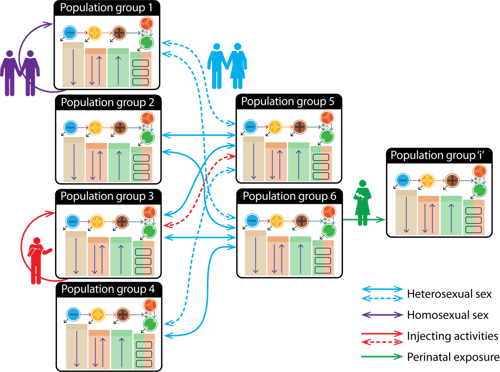Access Optima HIV
Open web app2023
Allocation of HIV Resources towards Maximizing the Impact of Funding in Selected Eastern European and Central Asian Countries: Findings from Optima HIV modeling analyses across 12 countries in Eastern Europe and Central Asia
Allocation of HIV Resources towards Maximizing the Impact of Funding in Selected Eastern European and Central Asian Countries - Albania
Allocation of HIV Resources towards Maximizing the Impact of Funding in Selected Eastern European and Central Asian Countries - Armenia
Allocation of HIV Resources towards Maximizing the Impact of Funding in Selected Eastern European and Central Asian Countries - Azerbaijan
Allocation of HIV Resources towards Maximizing the Impact of Funding in Selected Eastern European and Central Asian Countries - Belarus
Allocation of HIV Resources towards Maximizing the Impact of Funding in Selected Eastern European and Central Asian Countries - Georgia
Allocation of HIV Resources towards Maximizing the Impact of Funding in Selected Eastern European and Central Asian Countries - Kazakhstan
Allocation of HIV Resources towards Maximizing the Impact of Funding in Selected Eastern European and Central Asian Countries - Kosovo
Allocation of HIV Resources towards Maximizing the Impact of Funding in Selected Eastern European and Central Asian Countries - Kyrgyzstan
Allocation of HIV Resources towards Maximizing the Impact of Funding in Selected Eastern European and Central Asian Countries - Moldova
Allocation of HIV Resources towards Maximizing the Impact of Funding in Selected Eastern European and Central Asian Countries - Serbia
Allocation of HIV Resources towards Maximizing the Impact of Funding in Selected Eastern European and Central Asian Countries - Tajikistan
Allocation of HIV Resources towards Maximizing the Impact of Funding in Selected Eastern European and Central Asian Countries - Uzbekistan
2020
Improving Allocative Efficiency of the HIV Response in Kenya: A Country-Level Analysis Using the Optima HIV Model
Ending the AIDS epidemic in Cambodia
EECA English 2020; EECA Russian 2020
Improving efficiency of the HIV response in Malawi: Findings from an Optima HIV modelling analysis
Resource optimization to maximize the HIV response in Armenia
Resource optimization to maximize the HIV response in Azerbaijan
Resource optimization to maximize the HIV response in Belarus
Resource optimization to maximize the HIV response in Georgia
Resource optimization to maximize the HIV response in Kazakhstan
Resource optimization to maximize the HIV response in Kyrgyzstan
Resource optimization to maximize the HIV response in Moldova
Resource optimization to maximize the HIV response in Romania
Resource optimization to maximize the HIV response in Tajikistan
Resource optimization to maximize the HIV response in Ukraine
2019
Improving the Allocative Efficiency of the HIV Response Across the Care Cascade in Zimbabwe: Findings from a Modelling Analysis
Improving the allocative efficiency of Kosovo’s HIV response
2018
Optimizing Investments in the National HIV Response of Mexico
Optimizando la Inversión del Plan de Respuesta de Colombia al VIH
2017
Allocating HIV Funding Efficiently in Myanmar: Analyses Using the Optima HIV Model
Allocative Efficiency Analysis (HIV) 2015-2030 for Karnataka & Punjab — India
Optimización de las inversiones para la respuesta al VIH en Perú
Optimizing Investments for a Sustainable and Efficient HIV Response in Togo
Optimización de la inversión en VIH/SIDA en Argentina
Calvo N., Lavadenz F., Reporter I., Petravic J., Pantanali C., Lavadenz, C. (2017)
Ending AIDS in Johannesburg: An analysis of the status and scale-up towards HIV treatment and prevention targets.
Optimizing Investments for a Sustainable and Efficient HIV Response in Senegal: Findings from an HIV Allocative Efficiency Study
HIV Investment in Cote d’Ivoire: Optimized allocation of HIV resources for a sustainable and efficient HIV response
Optimizing investments in Bulgaria’s HIV response
The World Bank Group, Global Fund, UINAIDS, and UNDP for the Government of Bulgaria
Value for money in Ukraine’s HIV response: strategic investment and improved efficiency
Science addressing drugs and HIV: State of the Art: 2nd Scientific Statement
2Nd Scientific Statement March 2016
Allocative and implementation efficiency in HIV prevention and treatment for people who inject drugs
Efficiency In HIV Harm Reduction For PWID
Optimizing Investments in the National HIV Responses of Indonesia and Thailand: a Report for World Health Organization South-east Asia Regional Office
Who Sear Indonesia Thailand Report
2015
A Case Study on How Allocative Efficiency Analysis Supported by Mathematical Modelling Changed HIV Investment in Sudan. From Analysis to Action
Optimizing Investments in Moldova’s HIV Response
The World Bank Group, Global Fund, UNAIDS, and UNDP for the Government of Moldova
Optimizing investments in Former Yugoslav Republic of Macedonia’s HIV response
The World Bank Group for the Government of FYR Macedonia [PDF]
Modelling an Optimised Investment Approach for Uzbekistan: sustainable financing of National HIV responses
Zambia’s HIV Response: Prioritised and strategic allocation of HIV resources for impact and sustainability (findings from the HIV allocative efficiency study)
The World Bank Group and UNSW Australia for the Government of Zambia
Investing for Results: How Asia Pacific countries can invest for ending AIDS. High-level panel for AIDS Funding Landscape in Asia and the Pacific
2014
Sudan’s HIV response: Value for money in a low-level HIV epidemic; Findings from the HIV allocative efficiency study
The World Bank Group and UNSW Australia
Optimizing allocation of resources for HIV/AIDS responses: presented to the United Nations General Assembly
HIV Mathematical Modelling to Support Swaziland's Development of its HIV Investment Case
HIV resource needs, availabilities and gaps across ASEAN countries
Niger’s HIV response: Targeted investments for a health future. Findings from the HIV allocative efficiency and financial sustainability study
Ukraine HIV Program Efficiency Study: Can Ukraine improve value for money in HIV service delivery?
Ukraine HIV Program Efficiency Report Final With Cover
HIV Investment in Armenia: Analysis & Recommendations
Modelling an optimized investment approach for Tajikistan
Tajikistan Report Ru; Tajikistan Report En
Evaluation of a Decade of DFID and World Bank Supported HIV and AIDS Programmes in Vietnam from 2003 to 2012
HIV Resource Needs, Efficient Allocation and Resource Mobilization for the Republic of Belarus
2012
Assessment of the allocation of HIV funding in Indonesia.
2011
The Papua New Guinea HIV Model: explaining the past, describing the present, and forecasting the future of the HIV epidemic in PNG
PNG HIV Model Reports; PNG HIV Modeling Report Technical Appendix; PNG HIV Model Software Manual
Evaluation of the epidemiological impact of harm reduction programs on HIV in Vietnam
The HIV in Indonesia Model (HIM)
HIV In Indonesia (HIM) Report; HIM Software Manual
Epidemiology and modeling report on HIV/AIDS in the Philippines
Evaluation of the potential impact of the global economic crisis on HIV epidemics in Southeast Asia (prepared for AusAID)
Mathematical models to investigate recent trends in HIV notifications among men who have sex with men in Australia
- Optima HIV User Guide Overview
- HIV allocative efficiency analysis training workshop agenda and training materials ENGLISH (PDF)
- HIV allocative efficiency analysis training workshop agenda and training materials RUSSIAN (PDF)
- HIV allocative efficiency analysis training workshop agenda and training materials SPANISH (PDF)
Findings from Optima HIV applications and studies have been used to inform: the United Nations General Assembly, Global Fund to Fight AIDS, Tuberculosis and Malaria, Association of Southeast Asian Nations, national HIV/AIDS Strategic Plans, national Global Fund Concept Note applications, and country reports.
Optima HIV results can be used to improve country and health policy decision-making by informing domestic and donor public health funding allocations towards better achieving HIV targets.
The Optima HIV software was conceptualised and developed by the Optima Consortium for Decision Science with technical input from the World Bank, and is owned by Optima Consortium for Decision Science, Ltd. Optima HIV can be reached through www.hiv.optimamodel.com and is free and open source, with the code available for download on GitHub.
Optima HIV helps to:
- Identify HIV programs to be prioritized with available funding
- Determine resources required to reach HIV coverage targets and epidemiological objectives
- Establish the most cost-effective mix of HIV interventions to respond to a country’s HIV epidemic
- Reveal the investment allocation and coverage allocation for minimizing HIV incidence, HIV-related mortality, or both
- Calculate future treatment, care, and support costs for people affected by HIV or AIDS
- Estimate the number of new HIV infections and HIV-related deaths averted through existing or optimized investment.
2004 – ongoing
The primary Consortium partners for developing and applying the Optima suite of tools are University College London, University of Bern, and the University of New South Wales.
Optima tools have been developed and applied in close partnership and with funding from global health agencies including the: World Bank, Global Fund, and the U.S. Centers for Disease Control. Optima also receives funding from the Australian National Health and Medical Research Council.
The Optima HIV tool is part of the HIV Modelling Consortium, a group supporting evidence-informed decision making by facilitating the application of multiple mathematical models in sub-Saharan Africa.
HIV health states compartments and transmission-related interactions across the care cascade represented in Optima HIV

Risk-based population mixing patterns represented in Optima HIV

Funding
Partners
- World Bank
- Global Fund to Fight AIDS, Tuberculosis and Malaria
- U.S. Centers for Disease Control
- Australian National Health and Medical Research Council
Partners +
Collaborators
- University College London
- University of Bern
- University of New South Wales
Project
Team
Meet the project team. Together, we are translating research into better health, for all.








